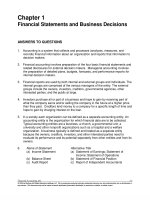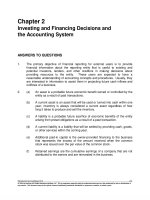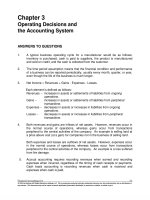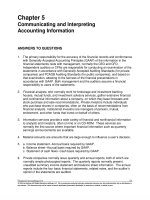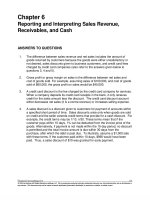Solution manual managerial accounting 8e by hansen mowen ch 5
Bạn đang xem bản rút gọn của tài liệu. Xem và tải ngay bản đầy đủ của tài liệu tại đây (235.35 KB, 36 trang )
To download more slides, ebook, solutions and test bank, visit
CHAPTER 5
ACTIVITY- BASED MANAGEMENT
QUESTIONS FOR WRITING AND DISCUSSION
1. The two dimensions are the cost dimension
and the process dimension. The cost dimension is concerned with accurate assignment of costs to cost objects, such as
products and customers. Activity-based
costing is the focus of this dimension. The
second dimension — the process dimension — provides information about why work
is done and how well it is done. It is concerned with cost driver analysis, activity
analysis, and performance measurement.
This dimension offers the connection to the
continuous improvement world found in the
advanced manufacturing environment.
2.
5. Activity inputs are the resources consumed
by an activity in producing its output. Activity
output is the result or product of an activity.
Activity output measurement simply means
the number of times the activity is performed.
6. Activity analysis is concerned with identifying activities performed by an organization,
assessing their value to the organization,
and selecting and keeping only those that
are value adding. Selecting and keeping
value-adding activities brings about cost reduction and greater operating efficiency,
thus providing support for the objective of
continuous improvement.
A functional-based responsibility accounting
system is characterized by four elements:
(1) a responsibility center, where responsibility is assigned to an individual in charge
(responsibility is usually defined in financial
terms); (2) the setting of budgets and standards to serve as benchmarks for performance measurement; (3) measurement of
performance by comparing actual outcomes
with budgeted outcomes; and (4) individuals
being rewarded or penalized according to
management policies.
7. Value-added activities are necessary activities. Activities are necessary if they are
mandated or if they are not mandated and
satisfy three conditions: (1) they cause a
change of state, (2) the change of state is
not achievable by preceding activities, and
(3) they enable other activities to be performed. Value-added costs are costs caused
by activities that are necessary and efficiently executed.
8. Nonvalue-added activities are unnecessary
activities or those that are necessary but inefficient and improvable. An example is
moving goods. Nonvalue-added costs are
those costs caused by nonvalue-added activities. An example is the cost of materials
handling.
3. In an activity-based responsibility accounting
system, the focus of control shifts from responsibility centers to processes and teams.
Management is concerned with how work is
done, not with where it is done. Process improvement and process innovation are emphasized. Standards tend to be optimal, dynamic, and process oriented. Performance
measurement focuses on processes and activities that define the processes. Finally,
there tends to be more emphasis on group
rewards than on individual rewards.
4. Driver analysis is concerned with identifying
the root causes of activity costs. Knowing
the root causes of activity costs is the key to
improvement and innovation. Once a manager understands why costs are being incurred, then efforts can be taken to improve
cost efficiency.
109
9.
(1) Activity elimination — the identification
and elimination of activities that fail to add
value. (2) Activity selection — the process of
choosing among different sets of activities
caused by competing strategies. (3) Activity
reduction — the process of decreasing the
time and resources required by an activity.
(4) Activity sharing — increasing the efficiency of necessary activities using economies
of scale.
10.
Value-added standards represent the absolute levels of efficiency for activities. The
costs that should be incurred for these abso-
To download more slides, ebook, solutions and test bank, visit
lute levels are value-added costs. Any difference between the actual costs incurred
and the ideal costs are nonvalue-added
costs.
11.
Trend reports will reveal the progress made
over time in reducing nonvalue-added costs.
12.
A kaizen standard is the planned improvement for the coming period. The kaizen subcycle implements the improvement, checks
it, and locks it in and then begins a search
for additional improvements. The maintenance subcycle sets a standard based on
prior improvements, executes, and checks
the results to make sure that performance
conforms to the new results. If not, then corrective action is taken.
13.
Benchmarking identifies the best practices
of comparable internal and external units.
For internal units, information can be gathered that reveals how the best unit
achieves its results; these procedures can
then be adopted by other comparable units.
For external units, the performance standard
provides an incentive to find ways to match
the performance (it may sometimes be possible to determine the ways the performance
is achieved).
14.
If individuals are asked to reduce costs and
are told what the activity driver is, they may
decrease the level of the driver below that
which is optimal. Thus, it may be necessary
to also identify the optimal level of the cost
driver so that only nonvalue-added costs are
eliminated.
15.
The activity volume variance is a measure of
the nonvalue-added costs. The unused capacity variance tells how much of the committed resources are not being used. This information is particularly important because it
helps managers know when they can take
actions to reduce nonvalue-added costs.
110
16. Activity-based customer costing can identify
what it is costing to service different customers. Once known, a firm can then devise
a strategy to increase its profitability by focusing more on profitable customers, converting unprofitable customers to profitable
ones where possible, and “firing” customers
that cannot be made profitable.
17.
Activity-based supplier costing traces all
supplier-caused activity costs to suppliers.
This new total cost may prove to be lower
than what is signaled simply by purchase
price.
To download more slides, ebook, solutions and test bank, visit
EXERCISES
5–1
1.
Plantwide rate = ($1,200,000 + $1,800,000+ $600,000)/60,000 = $60 per Machine
hour
Unit overhead cost = $60 × 50,000/100,000 = $30
Activity rates:
Machine rate = $1,800,000/60,000 = $30 per machine hour
Testing rate = $1,200,000/40,000 = $30 per testing hour
Rework rate = $600,000/20,000 = $30 per rework hour
Total overhead cost = ($30 × 50,000) + ($30 ×
= $2,250,000
20,000) + ($30 × 5,000)
Unit overhead cost = $2,250,000/100,000 = $22.50
Improving the accuracy reduced the cost by $7.50, which is still less than the
$10 reduction needed. What this means is that although accuracy has a positive effect on the price, it is not the only problem. It appears that competitors
may be more efficient than Timesaver. This outcome then signals the need to
reduce costs.
2.
Since testing and rework costs and setup and rework time are both reduced
by 50%, the activity rates remain the same, although the amount of cost assigned to the regular microwave will change:
Total overhead cost = ($30 × 50,000) + ($30 × 10,000) + ($30 × 2,500)
= $1,875,000
Unit cost = $1,875,000/100,000 = $18.75
This cost now is $11.25 less than the original allows management to reduce
the price by $10, increasing the competitive position of the regular model.
ABC is concerned with how costs are assigned, whereas ABM is not only
concerned with how they are assigned but also with how costs can be reduced. Cost accuracy and cost reduction are the dual themes of ABM.
111
To download more slides, ebook, solutions and test bank, visit
5–2
Classification:
Situation
1
2
3
4
5
6
7
Activity-Based
A
A
A
B
B
B
A
Functional-Based
B
B
B
A
A
A
B
Comments:
Situation 1: In a functional-based system, individuals are held responsible for the
efficiency of organizational units, such as the Grinding Department. In an activitybased system, processes are the control points because they are the units of
change; they represent the way things are done in an organization. Improvement
and innovation mean changing the way things are done, or in other words, changing processes. Since processes, such as procurement, cut across functional
boundaries, teams are the natural outcome of process management. It is only
natural that the managers of purchasing, receiving, and accounts payable be part
of a team looking for ways to improve procurement.
Situation 2: In a functional-based responsibility system, individuals in charge of
responsibility centers are rewarded based on their ability to achieve the financial
goals of the responsibility center. Thus, meeting budget promises the “fat” bonus. In a continuous improvement environment, process improvement is dependent on team performance, so rewards tend to be group based, and gainsharing
is often used. Furthermore, there are many facets to process performance other
than cost, so the performance measures tend to be multidimensional (e.g., quality
and delivery time).
112
To download more slides, ebook, solutions and test bank, visit
5–2
Concluded
Situation 3: In a functional-based system, efforts are made to encourage individuals to maximize the performance of the subunit over which they have responsibility. The concern of activity-based responsibility accounting is overall organizational performance. The focus is systemwide. It recognizes that maximizing
individual performance may not produce firmwide efficiency.
Situation 4: In a functional-based system, performance of subunits is usually
financial-based and is measured by comparing actual with budgeted outcomes. In
an activity-based system, process performance is emphasized. The objective is to
provide low-cost, high-quality products, delivered on a timely basis. Thus, both
financial and nonfinancial measures are needed.
Situation 5: In a functional-based system, budgets and standards are used to
control costs. In an activity-based responsibility system, the focus is on activities
because activities are the cause of costs. Driver analysis and activity analysis are
fundamental to the control process. Driver analysis recognizes that controlling
costs requires managers to understand the root causes. Activity analysis is the
effort expended to identify, classify, and assess the value content of all activities.
Once the value content is known, then costs can be controlled through such
means as activity reduction, activity elimination, activity sharing, and activity selection.
Situation 6: A functional-based system uses currently attainable standards that
allow for a certain amount of inefficiency. Achieving the standard is the emphasis, and there is no effort to improve on the standards themselves. An activitybased approach strives for the ideal, and so the standard is the ideal. Progress is
measured over time with the expectation that performance should be continually
improving. Efforts are made to find new ways of doing things and, thus, to find
new optimal standards. The objective is to always provide incentives for positive
changes.
Situation 7: The functional-based system tends to ignore a firm’s activities and
the linkages of those activities with suppliers and customers. It is internally focused. An activity-based system builds in explicit recognition of those linkages
and emphasizes the importance of the value chain. Furthermore, the assessment
of the value content of activities is explicitly related to customers. What goes on
outside the firm cannot be ignored.
113
To download more slides, ebook, solutions and test bank, visit
5–3
The ABM implementation is taking too long and is not producing the expected results. It also appears to not be integrated with the division’s official accounting
system, thus encouraging managers to continue relying on the old system (as
evidenced by the continued reliance on traditional materials and labor efficiency
variances). The fact that the ABC product costs are not significantly different in
many cases could be due to a lack of product diversity or perhaps due to poor
choices of pools and drivers. The lack of a competitive cost state suggests the
presence of significant nonvalue-added costs. The emphasis on the absence of
product cost differences, lack of cost reductions, and the attitude about activity
detail and the value content of inspection all reveal that plant managers have a
very limited understanding about ABM and what it can do. There clearly needs to
be a major effort to train managers to understand and use activity data. At this
point, there is no organizational culture that emphasizes the need for continuous
improvement. This need and the role ABM plays in continuous improvement
needs to be taught. The new ABM system also needs to be integrated to maximize
its chances for success.
5–4
1.
David was concerned about meeting the schedule and staying within the 5
percent variance guideline. The first week’s production exceeded the guideline for both materials and labor, and he expected the same outcome for the
second week. By stopping inspections, no materials waste would be observed and recorded for the second week, moving the usage variance back
within the 5 percent tolerance level. Accepting all units produced also will reduce the total labor time reported. Finally, using inspectors as production labor and counting their time as inspection labor provides some “free” direct
labor time, which would also contribute to the reduction or elimination of an
unfavorable labor efficiency variance. David’s behavior is unethical. David
(and perhaps others) is deliberately subverting the organization’s legitimate
and ethical objective of providing a high-quality product used in the manufacture of an airplane—in exchange for a favorable performance rating and, presumably, a good salary increase or bonus. Although no explicit information is
provided, the stress test seems to imply an important safety role for the bolts
in the airplane structure. If true, then David’s actions become even more
questionable.
114
To download more slides, ebook, solutions and test bank, visit
5–4
2.
Concluded
There appears to be an overreliance on standards and variances. There also
appears to be a strong internal focus—David did not give much consideration
to the effect of his decision on the company’s customers. The reward structure seems to be tied to the ability of David to meet or beat standards, and
this provides some incentive to engage in perverse and even unethical behavior. The system certainly works against the goal of zero defects and total
quality. An activity-based system would tend to mitigate the problem because
it encourages a multidimensional performance measurement. For example,
quality measures are important. Failure to meet measures on one dimension
may be offset to some extent by good performance on other dimensions. A
strategic-based approach would mitigate the behavior even more, as it adopts
a customer focus, and performance measures relating to such things as customer satisfaction are introduced. Furthermore, more effort is made to link
the performance measures with the company’s mission and strategy.
Finally, by communicating the strategy through the use of performance
measures of various perspectives, a strategic-based approach tends to align
individual goals with those of the organization. However, it should be mentioned that designing a system with perfect incentives is difficult. Ultimately,
the firm must rely on the character of its employees to carry out its objectives.
3.
The first week’s experience indicates a fairly high defect rate—between 7 and
8 percent—which was expected to continue for the second week. Apparently,
item-by-item inspection is the company’s way of ensuring reliable bolt performance. Abandoning the inspection process for a week simply to meet internal reporting standards seems like a weak excuse, even if a return to normal practices is expected. All too often, this sort of rationalization leads to
repeated violations of norms to meet short-term goals, and it becomes part of
the culture—to the point where it doesn’t appear to be wrong anymore. Fundamentally, the need for inspection and the high reject rate suggests that the
company needs to think about ways of improving its manufacturing process
to reduce the number of defective units. This is why an activity- or strategicbased approach may be more suitable because they both have a process focus that emphasizes quality and efficiency. Production of defective units
would not be encouraged.
115
To download more slides, ebook, solutions and test bank, visit
5–5
The following are possible sets of questions and answers (provided as examples
of what students could suggest):
Cleaning oil:
Question:
Answer:
Why is the oil puddle cleaned daily?
Because the production equipment leaks oil every day.
Question:
Answer:
Why does the production equipment leak oil?
Because a seal is damaged (root cause).
Question:
Answer:
How do we repair the damaged seal?
By replacing it.
Providing sales allowances:
Question:
Answer:
Why are we giving sales allowances?
Because the product is not working as it should.
Question:
Answer:
Why is the product not working as it should?
Usually because it has a defective component.
Question:
Answer:
Why does it have a defective component?
Because our subassembly processes occasionally produce bad
components.
Question:
Answer:
Why do our subassembly processes produce bad components?
Because our workers are not as well trained as they should be (root
cause).
Question:
Answer:
How do we improve the skills of our workers?
By ensuring that they all pass a rigorous training course.
116
To download more slides, ebook, solutions and test bank, visit
5–6
Nonvalue-added:
Comparing documents
Resolving discrepancies
(state detection) $90,000 (0.15 × $600,000)
(rework)
$420,000 (0.70 × $600,000)
Value-added:
Preparing checks $60,000 (0.10 × $600,000)
Mailing checks
$30,000 (0.05 × $600,000)
5–7
Questions 2–6 represent a possible sequence for the activity of comparing documents, and Questions 1 and 3–6 represent a possible sequence for resolving
discrepancies. The two activities have a common root cause.
Question 1: Why are we resolving discrepancies?
Answer:
Because the purchase order, receiving order, and invoice have been
compared and found to be in disagreement.
Question 2: Why are documents being compared?
Answer:
Because they may not agree.
Question 3: Why would the documents not agree?
Answer:
Because one or more may be wrong.
Question 4: Why would a document be wrong?
Answer:
Because the amount received from the supplier may not correspond
to the amount ordered or because the amount billed may not correspond to the amount received or both.
Question 5: Why are the amounts different?
Answer:
Because of clerical error—either by us or by the supplier.
Question 6: How can we avoid clerical error?
Answer:
Training for our clerks will reduce the number of discrepancies; for
suppliers, extra training and care can be suggested where there is
evidence of a problem.
117
To download more slides, ebook, solutions and test bank, visit
5–8
1.
A process is a collection of activities with a common objective. The common
objective of procurement is to supply bought and paid for materials to operations (e.g., the manufacturing process). The common objective of purchasing
is to produce a request for materials from suppliers; the common objective of
receiving is to process materials from suppliers and move them to the operations area (e.g., stores or manufacturing); the common objective of paying
bills is to pay for the materials received from suppliers.
2.
The effect is to reduce the demand for the activity of resolving discrepancies
by 30 percent. By so doing, Whitley will save 21 percent (0.30 × 0.70) of its
clerical time. Thus, about four clerks can be eliminated (21% * 20 clerks = 4
clerks eliminated) by reassigning them to other areas or simply laying them
off. This will produce savings of about $120,000 per year (4 clerks * $30,000
salary). This is an example of process improvement—an incremental increase
in process efficiency resulting in a cost reduction.
5–9
EDI eliminates the demand for virtually all the activities within the bill-paying
process. Some demand may be left for payment activities relative to the acquisition of nonproductive supplies. Assuming conservatively that 90 percent of the
demand is gone, then there would be a need for perhaps two clerks (10% * 20
clerks = 2 remaining clerks). This would save the company $540,000 (18 clerks *
$30,000 salary) per year for this subprocess alone. Additional savings would be
realized from reduction of demands for purchasing and receiving activities.
Switching to an EDI procurement structure is an example of process innovation.
118
To download more slides, ebook, solutions and test bank, visit
5–10
Case
A
B
C
D
E
F
Nonvalue-Added Cost
Root Cause
Cost Reduction
$9 per unit1
$300 per setup2
$120 per unit3
$400,000 per year4
$250 per unit5
$900,000 per year6
Process design
Product design
Plant layout
Multiple*
Suppliers
Product design
Activity selection
Activity reduction
Activity elimination
Activity selection
Activity elimination
Activity sharing
1
(0.5)$12 – (0.25)$8 + (8 – 7.5)$10
(8 – 2)$50
3
(6 – 0)$20
4
$320,000 + (16,000)$5
5
(6.5 – 6)$500
6
As given
2
*For example, process design, product design, and quality approach or philosophy.
5–11
Fixed activity rate = SP = $252,000/28,800 = $8.75 per order
Cost of unused capacity:
SP × SQ
$8.75 × 14,400
SP × AQ
$8.75 × 28,800
$126,000 U
Activity Volume Variance
SP × AU
$8.75 × 27,600
$10,500 F
Unused Capacity Variance
The activity volume variance measures the nonvalue-added cost. The unused
capacity variance is a measure of the potential to reduce the spending on an
activity and, thus, reduce the nonvalue-added costs.
119
To download more slides, ebook, solutions and test bank, visit
5–11
2.
Concluded
Value-added costs = $8.75 × 14,400 = $126,000
Nonvalue-added costs = $8.75 × 14,400 = $126,000
Note: For fixed activity costs, the practical capacity is currently 28,800 orders;
thus, 14,400 orders are unnecessary.
A value-added cost report would be as follows:
Purchasing
Value-Added
Costs
$126,000
Nonvalue-Added
Costs
$126,000
Actual
Costs
$252,000
Highlighting nonvalue-added costs shows managers where savings are possible and emphasizes the need for improvement. In this case, reducing orders
processed to 14,400 will create unused capacity of 14,400 orders, allowing the
company to save $126,000 in salaries.
3.
First, the value-added standard is nonzero. Second, purchasing enables other
activities to be performed. Third, there is a change of state—from a state of
no materials requested to a state of materials requested. Fourth, the purchase
state could not have been achieved by a prior activity. Fifth, it is a necessary
activity—one essential for the firm to remain in business.
Possible reasons for exceeding the value-added standard: suboptimal inventory management policies, reorders due to bad parts being delivered by suppliers, extra orders due to rework requirements, and additional orders because the wrong types and quantities of materials were ordered.
4.
By reducing the demand by another 6,000 units, the unused capacity will now
equal 7,200 orders—an amount equivalent to 1.5 purchasing agents. Thus,
the number of purchasing agents can be reduced from 6 to 5, saving $42,000.
120
To download more slides, ebook, solutions and test bank, visit
5–12
1.
Willson Company
Value- and Nonvalue-Added Cost Report
For the Year Ended December 31, 2005
Value-Added
Costs
Purchasing parts
$ 450,000
Assembling parts
2,160,000
Administering parts 1,980,000
Inspecting parts
0
Total
$4,590,000
2.
Nonvalue-Added
Costs
$ 180,000
234,000
858,000
1,125,000
$2,397,000
Actual
Costs
$ 630,000
2,394,000
2,838,000
1,125,000
$6,987,000
Inspecting parts is nonvalue-added (SQ = 0 is a necessary condition for a
nonvalue-added activity). Inspection is nonvalue-added because it is a statedetection activity, not a state-changing activity. It also is not essential to enable other activities to be performed. Value-added activities can engender
nonvalue-added costs if they are not performed efficiently.
5–13
1.
Willson Company
Nonvalue-Added Cost Trend Report
For the Year Ended December 31, 2006
Purchasing parts
Assembling parts
Administering parts
Inspecting parts
Total
2005
$ 180,000
234,000
858,000
1,125,000
$2,397,000
2006
90,000
72,000
660,000
675,000
$1,497,000
$
Change
$ 90,000 F
162,000 F
198,000 F
450,000 F
$900,000 F
Note: The above amounts were computed for each year, using the following
formula: (AQ – SQ)SP.
2.
A trend report allows managers to assess the effectiveness of activity management. It is a critical document that reveals the success of continuous
improvement efforts. It also provides some information about additional opportunity for improvement. In 2006, activity management reduced the
nonvalue-added costs by $900,000, signaling that the actions taken were
good. It also shows that additional opportunity for reduction exists—more effort is needed to reduce the $1,497,000 of remaining nonvalue-added costs.
121
To download more slides, ebook, solutions and test bank, visit
5–14
1.
Activity and driver analysis:
Setting up equipment: This is a value-added activity because (1) it causes a
change in the state of nature: improperly configured equipment to properly
configured equipment, (2) there is no prior activity that could have caused the
state change, and (3) it is necessary to enable other activities to be performed. However, setting up equipment often takes more time than needed
and so this activity has a nonvalue-added component. Most companies strive
for zero setup time. Thus, the time and associated cost are nonvalue-added
because the activity is performed inefficiently. Means should be explored to
reduce the time of this activity so that it consumes fewer resources. Possible
root causes include such factors as product design, process design, and
equipment design. Knowing the root causes can lead to an improvement in
activity efficiency. Moving from a departmental manufacturing structure to a
cellular manufacturing structure in some cases may eliminate the need for setups, thus eliminating the activity, or flexible manufacturing equipment might
be purchased that provides an almost instantaneous setup capability (a
change in process technology—and certainly a change in equipment design).
In other cases, the activity may be improved by redesigning the product so
that a less complicated setup is required.
Creating scrap: This is generally viewed as a nonvalue-added activity and
should be eliminated. It is nonvalue-added because it causes a nondesired
change of state and because it does not enable other value-added activities to
be performed. Efforts should be made to find ways of producing that eliminate scrap. Possible root causes include poor vendor quality, quality management approach, and manufacturing process used. Knowing the root causes may lead to a supplier valuation program that improves the quality of the
parts and materials purchased externally, adoption of a total quality management program, and perhaps the use of automated equipment to cut down on
material waste (because of greater precision).
Welding subassemblies: This is a value-added activity. It causes a desired
state change that could not have been done by preceding activities and
enables other activities to be performed. If inefficient, then means should be
sought to improve efficiency. The goal is to optimize value-added activity performance. Possible root causes include product design, process design, and
production technology. Changing either of the two designs could decrease
the demand for the welding activity while producing the same or more output.
A change in technology—buying more advanced technology, for example—
may also increase the efficiency of the activity.
122
To download more slides, ebook, solutions and test bank, visit
5–14
Continued
Materials handling: This is a nonvalue-added activity. Moving materials and
subassemblies from one point in the plant changes location but not the state.
But it does enable other activities to be performed, and it is not a repeated action. If you argue that changing location is a change in state, then moving materials is value-added but with the potential of significant increases in efficiency (as with setups, the goal is to minimize the amount of activity performance).
Possible root causes include plant layout, manufacturing processes, and vendor arrangements. Moving from a departmental to a cellular structure, adopting
computer-aided manufacturing, and entering into contracts with suppliers that
require just-in-time delivery to the point of production are examples of how
knowledge of root causes can be exploited to reduce and eliminate nonvalueadded activities.
Inspecting parts: Inspection is a nonvalue-added activity. It is a statedetection activity and is not necessary to enable other activities to be performed. This activity should be reduced and eventually eliminated. A possible
root cause of inspection is the possibility of poor quality of parts and materials. The company should work with suppliers to ensure high quality (zerodefect parts).
2.
Behavioral analysis:
Setting up equipment: Using the number of setups as a driver may cause a
buildup of inventories. Since reducing the number of setups will reduce setup
costs, there will be an incentive to have fewer setups. Reducing the number
of setups will result in larger lots and could create finished goods inventory.
This is in opposition to the goal of zero inventories. On the other hand, if setup time is used as the driver, managers will have an incentive to reduce setup time. Reducing setup time allows managers to produce on demand rather
than for inventory.
123
To download more slides, ebook, solutions and test bank, visit
5–14
Concluded
Creating scrap: Using the number of defective units as a driver should encourage managers to reduce defective units. Assuming that defective units
are the source of scrap, this should reduce scrap costs. Similarly, using
pounds of scrap should encourage managers to find ways to reduce scrap. In
both cases, the behavioral consequences could be two-edged. If the reduction of scrap (defective units) is achieved by increasing quality/productive efficiency, the effect is compatible with the objective of creating a competitive
advantage. If the reduction is achieved by allowing defective units to flow
through to finished goods, then the effect will be to alienate customers, not
win their favor (customer realization decreases). Neither driver appears to
dominate. One solution is to report the trend in warranty activity with the
trend in scrap activity. This may discourage any kind of pass-on behavior.
Welding subassemblies: Using welding hours should encourage management
to find ways of reducing the welding hours required per product. This would
be more likely to induce managers to look at possible root causes such as
product design and process design rather than number of welded subassemblies. There is some value in looking for ways to reduce the number of welded
subassemblies, perhaps redesigning the product to eliminate welding.
Materials handling: Both drivers seem to have positive incentives. Seeking
ways to reduce the number of moves or distance moved should lead managers to look at root causes. Reorganizing the plant layout, for example, should
reduce either the number of moves or the distance moved. Hopefully, the activity drivers will lead to the identification of executional drivers that can be
managed so that the activity can be reduced and eventually eliminated.
Inspecting parts: Hours of inspection can be reduced by working with suppliers so that greater incoming quality is ensured. Similarly, the number of defective parts can be reduced by working with suppliers so that incoming quality is increased. Hours of inspection, however, can be reduced without
increasing quality. This is not true for the number of defective parts. Using
the number of defective parts appears to be a better choice.
124
To download more slides, ebook, solutions and test bank, visit
5–15
1.
First quarter: Setup time standard = 10 hours (based on the planned improvement: 15 hours – 5 hours)
Second quarter: Setup time standard = 8 hours (based on the planned improvement: 9 hours – 1 hour)
2.
Kaizen subcycle:
• Plan (five-hour reduction from process redesign)
• Do (try out setup with new design)
• Check (time required was nine hours, a six-hour reduction)
• Act (lock in six-hour improvement by setting new standard of nine hours
and using same procedures as used to give the nine-hour outcome; and,
simultaneously, search for new improvement opportunity; in this case, the
suggested changes of the production workers.)
Repeat kaizen subcycle:
• Plan (one-hour reduction from setup procedure changes)
• Do (train and then implement procedures)
• Check (actual time required was 6.5 hours, a 2.5-hour reduction)
• Act (lock in improvement by setting standard of 6.5 hours and begin search
for new improvement)
3.
Maintenance subcycle:
First quarter (end of):
• Establish standard (nine hours based on improved process design)
• Do (implement repetitively the improved standard)
• Check (see if the nine-hour time is maintained)
• Act (if the nine-hour time deteriorates, find out why and take corrective action to restore to seven hours.)
Second quarter: Same cycle using 6.5 hours as the new standard to maintain
Note: The maintenance cycle described begins after observing the actual improvement. The actual improvement is locked in. The maintenance standard
at the beginning of the first quarter is 15 hours.
125
To download more slides, ebook, solutions and test bank, visit
5–15
Concluded
4.
Nonvalue-added cost saved (eliminated): $100 × 8.5 = $850 per setup.
5.
Standard costing basically uses only a maintenance subcycle. Standards are
set and maintained. The principal difference is the emphasis on constantly
searching for improvements with the standard changing with each improvement. This search involves all employees (e.g., engineers and production
workers). Thus, kaizen costing is dynamic, whereas traditional (functionalbased) standard costing is static.
5–16
1.
Salesa
Allocationb
JIT
$25,000,000
1,500,000
Non-JIT
$25,000,000
1,500,000
a
$125 × 200,000, where $125 = $100 cost + ($100 × 0.25) markup on cost, and
200,000 is the average order size times the number of orders
JIT : 400 orders * 500 average order size = 200,000
Non-JIT:
40 orders * 5,000 average order size = 200,000
b
2.
0.50 × $3,000,000
Activity rates:
Ordering rate = $1,760,000/440= $4,000 per sales order
Selling rate = $640,000/80 = $8,000 per sales call
Service rate = $600,000/300 = $2,000 per service call
126
To download more slides, ebook, solutions and test bank, visit
5–16
Concluded
JIT
Ordering costs:
$4,000 × 400
$4,000 × 40
Selling costs:
$8,000 × 40
$8,000 × 40
Service costs:
$2,000 × 200
$2,000 × 100
Total
Non-JIT
$ 1,600,000
$ 160,000
320,000
320,000
400,000
$ 2,320,000
200,000
$ 680,000
For the non-JIT customers, the customer costs amount to $1,500,000/40 =
$37,500 per order under the original allocation. Using activity assignments,
this drops to $680,000/40 = $17,000 per order, a difference of $20,500 per order. For an order of 5,000 units, the order price can be decreased by $4.10 per
unit without affecting customer profitability. Overall profitability will decrease,
however, unless the price for orders is increased to JIT customers.
3.
It sounds like the JIT buyers are switching their inventory carrying costs to
Carbon without any significant benefit to Carbon. Carbon needs to increase
prices to reflect the additional demands on customer-support activities. Furthermore, additional price increases may be needed to reflect the increased
number of setups, purchases, and so on, that are likely occurring inside the
plant. Carbon should also immediately initiate discussions with its JIT customers to begin negotiations for achieving some of the benefits that a JIT
supplier should have, such as long-term contracts. The benefits of long-term
contracting may offset most or all of the increased costs from the additional
demands made on other activities.
127
To download more slides, ebook, solutions and test bank, visit
5–17
1.
Supplier cost:
First, calculate the activity rates for assigning costs to suppliers:
Inspecting components: $240,000/2,000 = $120 per sampling hour
Reworking products: $760,500/1,500 = $507 per rework hour
Warranty work: $4,800,000/8,000 = $600 per warranty hour
Next, calculate the cost per component by supplier:
Supplier cost:
Vance
Purchase cost:
$23.50 × 400,000
$21.50 × 1,600,000
Foy
$ 9,400,000
$ 34,400,000
Inspecting components:
$120 × 40
$120 × 1,960
4,800
235,200
Reworking products:
$507 × 90
$507 × 1,410
45,630
714,870
Warranty work:
$600 × 400
$600 × 7,600
Total supplier cost
Units supplied
Unit cost
240,000
$ 9,690,430
÷ 400,000
$
24.23*
4,560,000
$ 39,910,070
÷ 1,600,000
$
24.94*
*Rounded
The difference is in favor of Vance; however, when the price concession is
considered, the cost of Vance is $23.23, which is less than Foy’s component.
Lumus should accept the contractual offer made by Vance.
128
To download more slides, ebook, solutions and test bank, visit
5–17
2.
Concluded
Warranty hours would act as the best driver of the three choices. Using this
driver, the rate is $1,000,000/8,000 = $125 per warranty hour. The cost assigned to each component would be:
Vance
Lost sales:
$125 × 400
$125 × 7,600
Foy
$ 50,000
$ 50,000
÷ 400,000
$
0.13*
Units supplied
Increase in unit cost
*Rounded
129
$ 950,000
$ 950,000
÷ 1,600,000
$
0.59*
To download more slides, ebook, solutions and test bank, visit
PROBLEMS
5–18
1.
An activity driver measures the amount of an activity consumed by a cost object. It is a measure of activity output. Activity drivers are used to assign activity costs to cost objects. On the other hand, a cost driver is the root cause
of the activity and explains why the activity is performed. Cost drivers are
useful for identifying how costs can be reduced (rather than assigned).
2.
Value content and driver analysis:
Setting up equipment: At first glance, this appears to be a value-added activity because: (1) it causes a change in the state of nature: improperly configured equipment to properly configured equipment, (2) there is no prior activity that should have caused the state change, and (3) it is necessary to enable
other activities to be performed. However, setting up equipment often takes
more time than needed and so has a nonvalue-added component. Most companies strive for zero setup time, suggesting that the time and associated
cost are nonvalue-added because the activity is performed inefficiently. (A zero setup time suggests a nonvalue-added activity.) Means should be explored
to reduce the time of this activity so that it consumes fewer resources. Possible root causes include such factors as product design, process design, and
equipment design. Knowing the root causes can lead to an improvement in
activity efficiency. Moving from a departmental manufacturing structure to a
cellular manufacturing structure in some cases may eliminate the need for setups, thus eliminating the activity. Or flexible manufacturing equipment might
be purchased that provides an almost instantaneous setup capability (a
change in process technology—and certainly a change in equipment design).
In other cases, the activity may be improved by redesigning the product so
that a less complicated setup is required.
Performing warranty work: This is generally viewed as a nonvalue-added activity and should be eliminated. It is nonvalue-added because it represents a
type of rework—repairs on products that are caused by faulty production.
Possible root causes include poor vendor quality, poor product design, quality management approach, and manufacturing process used. Knowing the
root causes may lead to a supplier valuation program that improves the quality of the parts and materials purchased externally, adoption of a total quality
management program, product redesign, process redesign, and perhaps the
use of automated equipment to cut down on faulty products.
130
To download more slides, ebook, solutions and test bank, visit
5–18
Continued
Welding subassemblies: This is a value-added activity. It causes a desired
state change that could not have been done by preceding activities and
enables other activities to be performed. If inefficient, then means should be
sought to improve efficiency. The goal is to optimize value-added activity performance. Possible root causes of inefficiency include product design,
process design, and production technology. Changing either product or
process design could decrease the demand for the welding activity while
producing the same or more output. A change in technology—buying more
advanced technology, for example—may also increase the efficiency of the
activity.
Moving materials: This is usually viewed as a nonvalue-added activity. Moving materials and subassemblies from one point in the plant changes location
but not the state. But it does enable other activities to be performed, and it is
not a repeated action. If it is argued that changing location is a change in
state, then you could respond by noting that it is an unnecessary change of
state. Possible root causes include plant layout, manufacturing processes,
and vendor arrangements. Moving from a departmental to a cellular structure,
adopting computer-aided manufacturing, and entering into contracts with
suppliers that require just-in-time delivery to the point of production are examples of how knowledge of root causes can be exploited to reduce and eliminate material handling cost.
Inspecting components: Inspection is a nonvalue-added activity. It is a statedetection activity and is not necessary to enable other activities to be performed. This activity should be reduced and eventually eliminated. A possible
root cause of inspection is the possibility of poor quality of parts and materials. The company should work with suppliers to ensure high quality (zerodefect parts).
131
To download more slides, ebook, solutions and test bank, visit
5–18
3.
Concluded
Behavioral analysis:
Setting up equipment: Using the number of setups as a driver may cause a
buildup of inventories. Since reducing the number of setups will reduce setup
costs, there will be an incentive to have fewer setups. Reducing the number
of setups will result in larger lots and could create finished goods inventory.
This is in opposition to the goal of zero inventories. On the other hand, if setup time is used as the driver, managers will have an incentive to reduce setup time. Reducing setup time allows managers to produce on demand rather
than for inventory.
Performing warranty work: Using the number of defective units as a driver
should encourage managers to reduce defective units. Assuming that defective units are the source of warranty work, this should reduce warranty costs.
Similarly, using warranty hours could encourage managers to find ways to
reduce warranty work by decreasing its causes. Alternatively, it may cause
them to look for more efficient means of performing warranty work. Increasing the efficiency of a nonvalue-added activity has some short-run merit but it
should not be the focus. Of the two drivers, defective units is the most compatible with eventual elimination of the nonvalue-added activity.
Welding subassemblies: Using welding hours should encourage management
to find ways of reducing the welding hours required per product. This would
more likely induce managers to look at possible root causes such as product
design and process design than would number of welded subassemblies.
There is some value in looking for ways to reduce the number of welded subassemblies, perhaps redesigning the product to eliminate welding.
Moving materials: Both drivers seem to have positive incentives. Seeking
ways to reduce the number of moves or distance moved should lead managers to look at root causes. Reorganizing the plant layout, for example, should
reduce either the number of moves or the distance moved. Hopefully, the activity drivers will lead to the identification of executional drivers that can be
managed so that the activity can be reduced and eventually eliminated.
Inspecting components: Hours of inspection can be reduced by working with
suppliers so that greater incoming quality is ensured. Similarly, the number of
defective parts can be reduced by working with suppliers so that incoming
quality is increased. Hours of inspection, however, can be reduced without
increasing quality. This is not true for the number of defective parts. Using
the number of defective parts appears to be a better choice.
132
To download more slides, ebook, solutions and test bank, visit
5–19
1.
Activity-based management is a systemwide, integrated approach that focuses management’s attention on activities. It involves two dimensions: a cost
dimension and a process dimension. A key element in activity management is
identifying activities, assessing their value, and retaining only value-adding
activities. The consultant identified the activities but did not formally classify
the activities as value-added or nonvalue-added. Nor did the consultant offer
any suggestions for increasing efficiency—at least not formally. The consultant apparently had tentatively identified savings possible by eliminating
nonvalue-added activities. Management must still decide how to reduce, eliminate, share, and select activities to achieve cost reductions.
2.
Setup
Materials handling
Inspection
Customer complaints
Warranties
Storing
Expediting
Total
$125,000
180,000
122,000
100,000
170,000
80,000
75,000
$852,000
Units produced and sold
÷120,000*
Potential unit cost reduction
$
7.10
*$1,920,000/$16 (total cost divided by unit cost)
The consultant’s estimate of cost reduction was on target. Per-unit costs can
be reduced by at least $7, and further reductions may be possible if improvements in value-added activities are possible.
3.
Total potential reduction:
$ 852,000 (from Requirement 2)
150,000 (by automating)
$1,002,000
Units
÷ 120,000
Unit savings
$
8.35
Costs can be reduced by at least $7, enabling the company to maintain current market share. Further, if all the nonvalue-added costs are eliminated,
then the cost reduction needed to increase market share is also possible. Activity selection is the form of activity management used here.
133




